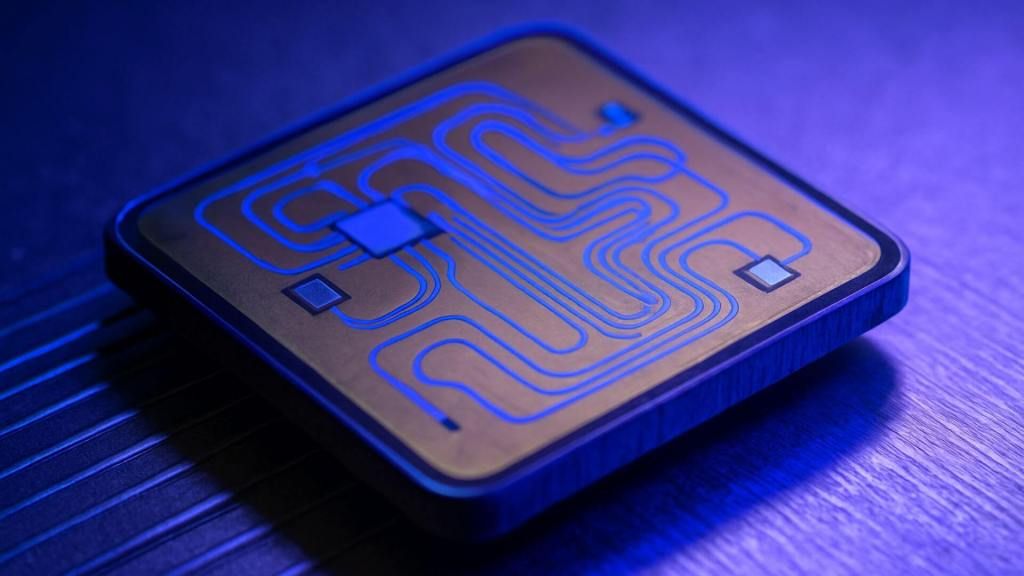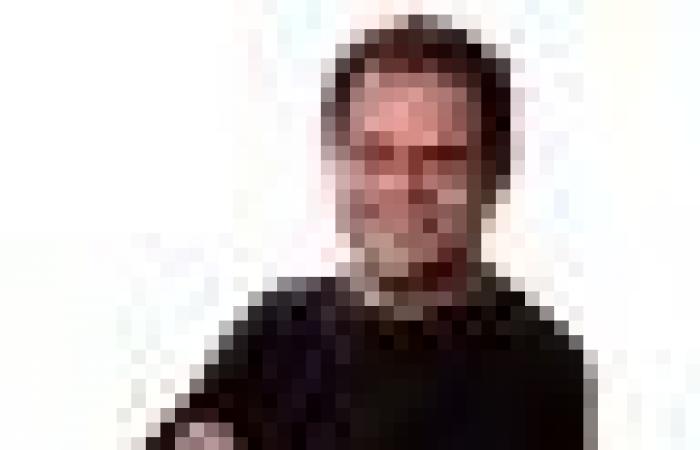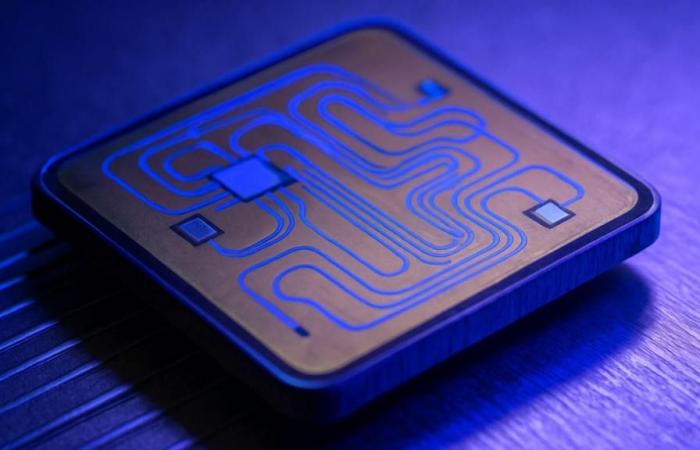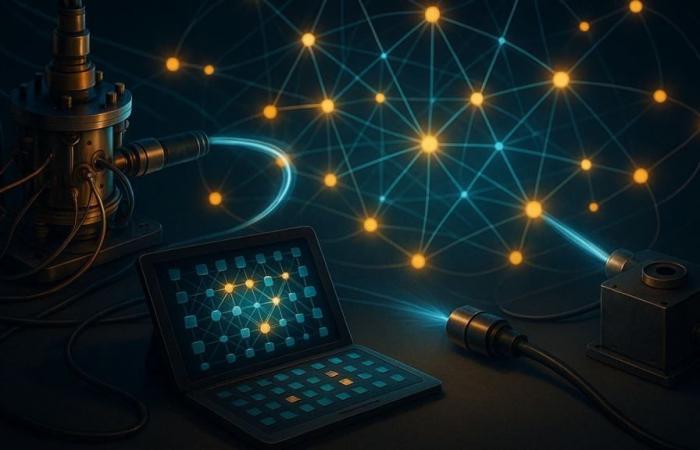Created: 7.05.2025 | 19:47 Updated: 7.05.2025 | 20:11
No one needs to explain how dependent we are from the Internet. We use it to send messages, make video calls, consult sensitive information and even manage financial transactions. But, What would happen if someone could intercept that information without us noticing it? Today, that risk exists. However, a group of researchers has demonstrated a radically new form of transmitting data: a real step towards the so -called “quantum Internet”, a network in which information not only travels at the speed of light, but is physically impossible to clone or spy without leaving a mark.
This advance is backed by an article published in Optical as much In April 2025, signed by researchers at Rochester Institute of Technology, the University of Rochester and other institutions. In it, there is a hybrid system that combines nonlinear crystals and integrated photonic circuits to generate and manipulate pairs of intertwined photons. This technology not only solves some of the main bottlenecks of current quantum networks, but also works using materials compatible with fiber optic networks that already exist throughout the world.
A quantum network that already works
Unlike many theoretical proposals or laboratory assemblies, the experiment presented in the Paper is based on real, miniaturized components and ready for integration. The system uses a crystal called PPKTP – Titanyl Potassium Phosphate periodically polarized – to generate pairs of photons with very different wavelengths: one in the visible range (656 Nm) and another in the telecommunications range (1536 Nm).
These photons are intertwined, which means that They share a quantum relationship that makes them inseparable in terms of information. This entanglement is key to allowing information safely. when detecting the visible photon, it can be guaranteed that its partner – the photon in telecommunications band – exists and can be used to transmit a coded data.
But the true strong point of the project is not only the generation of photons, but its manipulation and detection within a Integrated photonic chip. According to the authors, “We demonstrate a platform that allows remote quantum nodes to communicate safely through fiber optic networks”.

Light cubits for nets impossible to hack
On the conventional Internet, the data is transmitted by electric or light pulses that represent bits: zeros and some. In a quantum network, the protagonists are the cubits (quantum bits), which may be in a superposition of states. This allows new ways to code and process information. Photons are ideal candidates to function as “flying” cubits, as they travel fast, interact little with the environment and can be sent through the optical fibers that already exist.
The proposal of these researchers focuses on generating pairs of photons where one of them acts as “Heraldo”: if it is detected, it guarantees that their partner is available to transmit information. This system of heralded photons It allows communication with much greater reliability. And the most innovative: Everything happens on a compact device, which combines the PPKTP glass with an integrated photonic circuitwithout the need for the huge and expensive superconductor detectors that are usually used to capture individual photons.

A step towards deployable quantum networks
One of the biggest challenges to build real quantum networks is the complexity of its components. Until now, many montages required specialized laboratories, optics aligned with millimeter precision and refrigerated detectors at cryogenic temperatures. This project breaks that barrier when presenting a miniaturized, stable and easily packing platform.
The key is in the combination of non -linear glass with the chip. As the Paper explains, “integrated photonic circuits offer a compact and stable platform in phase for the routing and manipulation of low losses photons.” This means that the network can be manufactured on a large scale, something essential for its real implementation.
In addition, the chip integrates elements such as Mach-Zehnder interferometers that allow modulating the state of the photon. This opens the door not only to the transmission, but also to the quantum processing of the information. A network of this type could be used to connect distributed quantum computersremote sensors or unbreakable encryption systems.
Measured results, not simulated
The article is not limited to proposing an architecture: it shows that it works. The researchers measured coincidence rates between photons, losses of insertion in the different system components and detection rates in different configurations. The system reached a photon pairs generation index of up to 67 million per second and an adequate signal/noise ratio for practical applications.
A remarkable innovation is the use of silicon in the chip as a noise filter. The material itself acts as a pumping light suppressor that could interfere with the useful signals, eliminating the need for external filters. According to the study, “Silicon wave guides can provide a superior pumping suppression to external filters, improving the coincidences rate”.
The possibility of replacing cryogenic detectors with avalanche diodes spad, which work at room temperature was also evaluated. This allows the nodes of the quantum network to be deployed under normal conditions, outside the laboratory, and continue working reliably.

Proven in a real network
The team did not settle for testing its system in a controlled environment. In one of the most striking experiments, they connected their device to a real -length fiber optical fiber network, the call Rochester Quantum Network (RoQNET)that links the Rochester Institute of Technology with the University of Rochester. The signal was modulated, sent and received correctly, demonstrating that the system is compatible with existing infrastructure.
Despite the inevitable losses in the channel (more than 23 dB), the detection of coincidences was possible. This is a crucial step for future large -scale quantum networks. As a summary, the authors indicate that “This approach offers phase stability and a much lower device size compared to traditional free space or fiber systems”.
The pending task
Although the results are promising, researchers recognize limitations. The system still suffers from certain coupling losses, especially when transferring photons from the glass to the chip. Slight unwanted fluorescence was also detected in some components, which could be reduced in future versions using lower optical noise materials.
In addition, although an efficiency of generation of photons pairs close to the theoretical maximum (67 MHz/MW was achieved compared to the 80 MHz/MW planned), the final efficiency of the complete system – from the generation until the detection – can still be optimized. According to the authors, “The efficiency of an estimated heraldado in chip was 5.49 ± 1.63 %”.
The chip design was made with a non -optimized multipurpose platform. In future versions this part is expected to improve, reducing losses and increasing the general efficiency of the system.
Towards a global quantum network
This work is not a simple laboratory experiment: it represents a firm step towards the deployment of real, safe and scalable quantum networks. The integration of photons sources, chip manipulation and efficient detection paves the path to the quantum Internet of the future. An internet in which each message will be protected by the fundamental laws of physics and not by algorithms that, sooner or later, can be violated.
Applications are huge: from Safe military communicationsuntil Invulnerable bank cryptographygoing through high precision quantum sensor networks. This advance places the scientific community a step closer to a new era of connectivity. And, above all, it shows that science fiction can become a functional network made of cubits, photons and silicon chips.
References
- Vijay S. S. Sundaram, Evan Manfreda-Schulz, Todd Hawthorne, Tony Roberts, Thomas Palone, Venkatesh Deenadayalan, Mario Ciminelli, Phil Battle, Gerald Leake, Daniel Coleman, Michael L. Fanto, Nick Vamivakas, Gregory A. Howland y Stefan F. Preble. Heralded telecom single photons from a visible–telecom pair source on a hybrid PPKTP–PIC platform. Optical as muchVol. 3, No. 2, April 2025. DOI: 10.1364/OPTICAQ.546774.












